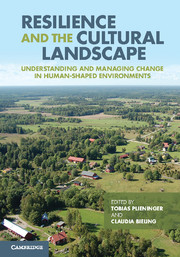 Resilience and the Cultural Landscape
Resilience and the Cultural Landscape Book contents
- Frontmatter
- Contents
- List of contributors
- Preface
- Part I Conceptualising landscapes as social–ecological systems
- 1 Connecting cultural landscapes to resilience
- 2 Landscapes as integrating frameworks for human, environmental and policy processes
- 3 From cultural landscapes to resilient social–ecological systems: transformation of a classical paradigm or a novel approach?
- 4 Conceptualising the human in cultural landscapes and resilience thinking
- 5 System or arena? Conceptual concerns around the analysis of landscape dynamics
- 6 Resilience thinking versus political ecology: understanding the dynamics of small-scale, labour-intensive farming landscapes
- Part II Analysing landscape resilience
- Part III Managing landscapes for resilience
- Part IV Perspectives for resilient landscapes
- Index
- References
4 - Conceptualising the human in cultural landscapes and resilience thinking
Published online by Cambridge University Press: 05 November 2012
- Frontmatter
- Contents
- List of contributors
- Preface
- Part I Conceptualising landscapes as social–ecological systems
- 1 Connecting cultural landscapes to resilience
- 2 Landscapes as integrating frameworks for human, environmental and policy processes
- 3 From cultural landscapes to resilient social–ecological systems: transformation of a classical paradigm or a novel approach?
- 4 Conceptualising the human in cultural landscapes and resilience thinking
- 5 System or arena? Conceptual concerns around the analysis of landscape dynamics
- 6 Resilience thinking versus political ecology: understanding the dynamics of small-scale, labour-intensive farming landscapes
- Part II Analysing landscape resilience
- Part III Managing landscapes for resilience
- Part IV Perspectives for resilient landscapes
- Index
- References
Summary
Introduction
This chapter starts from the contradiction that, while the empirical evidence demonstrates increasingly how inextricably humans have become embedded in earth surface and atmospheric processes, we maintain separationist ways of talking about things. Our dominant metaphors – cultural landscapes, social–ecological systems, human impacts, human interaction with the environment, anthropogenic climate change – all contain within them a dualistic construction of humans and the non-human world (often otherwise known as nature). The chapter makes broad comparisons between cultural landscapes approaches and social–ecological systems frameworks, as used in resilience thinking, in how they each conceptualise the human and human agency. These conceptualisations have political and policy implications for management decisions that are also discussed. The chapter then explores the possibilities of going beyond dualistic framings, using more relational perspectives.
Drawing on anglophone sources, I examine how the human–nature relationship has been conceptualised in the cultural landscape literature, and how these conceptualisations have changed over time. There are also significant geographical differences, as I show by comparing some Old and New World examples. In particular, I am concerned to interrogate the extent to which the human (including human processes and systems) has been conceptualised as separate to, and distinct from, the non-human or more-than-human world. I argue that much of the work of the cultural landscape concept, at least in the Anglo-American tradition (and its Australian manifestations), has been oppositional.
- Type
- Chapter
- Information
- Resilience and the Cultural LandscapeUnderstanding and Managing Change in Human-Shaped Environments, pp. 65 - 79Publisher: Cambridge University PressPrint publication year: 2012
References
- 9
- Cited by


